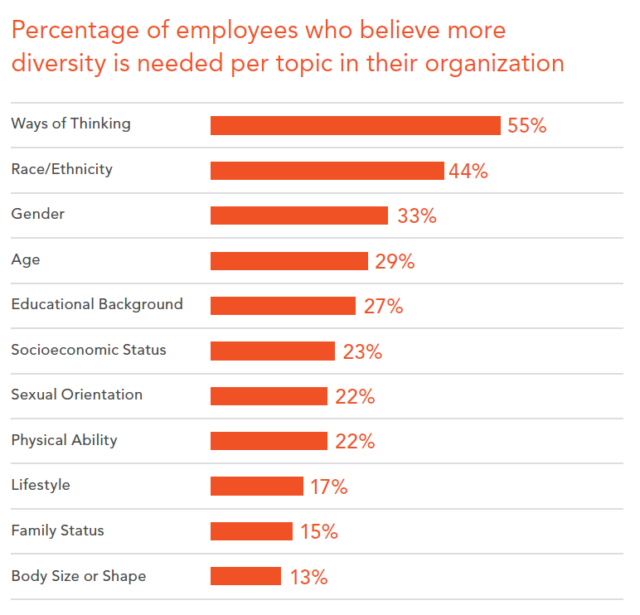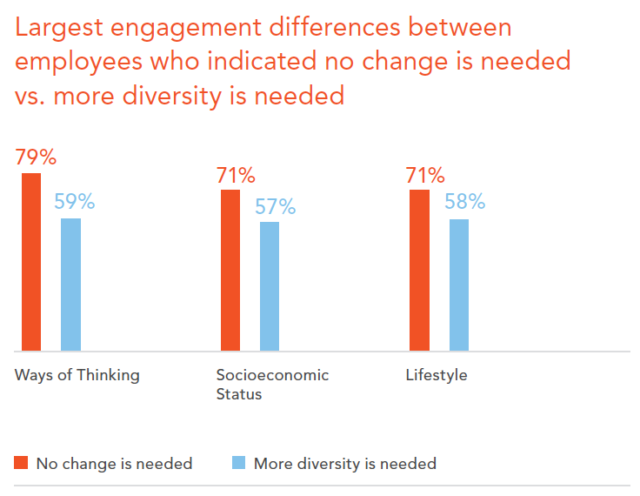
Race, gender and age have dominated conversations about diversity in the workplace. These conversations are important, and there’s still much work to be done. However, there’s more to diversity than demographic characteristics.
One area that is becoming increasingly more important is cognitive diversity—defined as differences in opinions, worldviews, beliefs and ways of thinking.
Why is cognitive diversity important?
Having a variety of thinking patterns and preferences is critical to a thriving culture and an innovative workplace. People who bring different perspectives can identify threats and opportunities that others may miss. This chemistry of human interaction is now seen as a critical component of innovation.
One study found that cognitive diversity can enhance team innovation by up to 20 percent, and it can reduce risks taken by up to 30 percent. Another study found that teams solve problems faster when they’re more cognitively diverse. In summary, groups with more diversity of thought perform better and faster than groups with less.
“Cognitive diversity leads to faster problem solving and to better, more innovative solutions. It also helps with overall communication. When you have a team that has diversity of thought, you have this collective of people who outperform teams that don’t have a spectrum of perspectives.”
– Marie Unger, President of Emergenetics International
Cognitive diversity is also a powerful addition to the overall narrative surrounding diversity and inclusion at work. Deloitte identifies three reasons that diversity of thought is so powerful:
- It creates a stronger and broader narrative about the case for diversity—one where everyone feels included and part of a shared goal.
- It more accurately reflects the complex nature of humans, rather than focusing only on one specific aspect of social or demographic identity.
- It recognizes that demographic equality—rather than being its own end—is a visible indicator of progress in welcoming a variety of perspectives.
What do employees think about diversity of thought?
Our research shows that more than half (55 percent) of employees believe more cognitive diversity is needed within their organizations.
In the chart below, you can see the breakdown of topics where employees believe more diversity is needed within their organization.

How does cognitive diversity impact employee engagement?
We know that employees aren’t completely satisfied with diversity in their organizations, yet how does that impact their engagement? Our research shows there’s a connection.
We compared engagement levels between employees who indicated that no change was needed in diversity versus those who indicated that more is needed.

We found employees who believe no change is needed tend to be more engaged than those who believe more diversity is needed. This finding is especially pronounced for cognitive diversity, with roughly a 20 percentage-point difference in engagement between employees.
Eight tips for increasing cognitive diversity in your organization
It’s clear that employees want to see a variety of perspectives represented in their companies—and that it makes a difference in employee engagement. So how can you increase cognitive diversity in your organization? Consider the following tips:
1. Invest in the process.
Take time to understand your goals and commit to the process involved to reach those goals. What does cognitive diversity look like in your organization? What steps will you have to take to get there? How will you adjust if the process isn’t working?
2. Create a psychologically safe workplace.
Invite all employees to recognize, contribute to and promote a culture that values and integrates different perspectives. Help employees develop behaviors and habits that are welcoming of others’ viewpoints and feelings.
3. Provide learning experiences.
Give employees opportunities to gain the skills needed to navigate conflict and differing perspectives. These experiences could come in the form of team or personal development exercises that allow employees to reflect on and test their beliefs, qualities and behaviors.
4. Expand recruitment efforts.
Visit local colleges or universities. Seek out specializations that aren’t strongly represented in your current workforce, and recruit individuals with different sources of training.
5. Assemble multi-disciplinary task forces for new strategies and initiatives.
If you’re putting together a task force with six employees, try to ensure that six different departments or divisions are represented. While doing so won’t be appropriate for all situations, it should be considered as an alternative.
6. Get input from every level of the organization.
It’s essential to gather opinions and insights from as many employees as you can, whether it’s through surveys, town halls or online forums. Leaders typically have the final say in strategic direction, but their decisions should be informed by the perspectives their employees can offer.
7. Coach managers on the importance of employee voice.
Cognitive diversity will have little impact if employees don’t feel like they can voice their opinions. Managers arguably play the most significant role in determining whether employees feel safe being open with their unique perspectives.
8. Tap into employees’ cognitive profiles.
Psychometric assessments (like Emergenetics) can offer a glimpse into how employees think and how they are most likely to respond to certain situations. Don’t let these tests replace the process of getting to know your employees, however.
Instead, use the results of these assessments to enhance your efforts to understand the differing perspectives in teams across the organization and utilize their unique insights.
Want to learn how you can identify and promote cognitive diversity and inclusion in your organization? Fill out the form below to connect with an Emergenetics team member today.
 Print This Post
Print This Post
